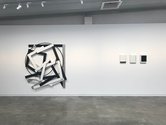John Hurrell – 5 October, 2019
The size of this vaguely circular, airy, construction gives the turning (but fixed) flat panels considerable clout. It seems like a nod to Frank Stella whilst being calculatedly limited in its colour. The short curving vectors of the left are a foil to the long vertical and high horizontal planks of the right, while in the centre its sweeping turning bars provide a rotational energy.
This major show from one of the world’s greatest colourists presents in the front annex/corridor six Knoebel works on paper (mostly Faces (2003-2016)—rectangular structures juxtaposing handpainted horizontal & vertical bands of paper—unfortunately positioned over a table, lamps and flowers), and in the main gallery, seven looser, more painterly (more sculptural) and more robust paintings that feature aluminium as a support.
Dominating the large room is Cut-up 6, a spectacular configuration of tumbling black, white and grey bars, overlapping, spiralling and weaving around a coil-like black line of hose piping.
The size of this vaguely circular, airy, construction gives the turning (but fixed) flat panels considerable clout. It seems like a nod to Frank Stella whilst being calculatedly limited in its colour. The short curving vectors of the left are a foil to the long vertical and high horizontal planks of the right, while in the centre its sweeping turning bars provide a rotational energy.
Knoebel’s other (much smaller) works mix chromatic investigation with tone-often through paired or tripled units of stable rectangular composition. You compare the different blocks of butted-together panels (series Anima Mundi; Face): seeing which colours are repeated, which are not; which painted columns are chromatically ‘clean’, which have discreetly agitated blended mixtures; which are tonally balanced, which are asymmetrical; which have vertical bristle marks in their vertical strips, and which also have horizontal smears on their bottom edges.
Then there are the paintings that investigate shape, edge and negative space—sometimes with dense pigment, sometimes with thin (series BIG GIRL; Nummer; Elemente). The two BIG GIRL works show the silhouettes of female heads with tousled hair caught in the wind. The paint is thin with expressive underpainting and scumbling, much of that involving skin tones and delicate (not obvious) smudges of metallic gold colour—and implies an affection towards the very private personal reference.
Nummer 37-39 (2012) and Elemente T.2. (2018) again celebrate contours and the power of shape that works with colour. Their morphological unpredictability is a nice contrast with the more architectural rectangular pieces with their formal vertical and repetitive geometry.
Overall this excellent exhibition is something to be remembered, especially with the exuberant dynamism of the wonderful centre-piece, Cut-up 6. The presentation’s rejection of overt narrative is now extremely salient in the current climate of multiple storytelling, the search for justice, planetary survival and diverse identity politics. Whilst it might be argued it waves its own political flags, and harangues through its own loud hailers, this show reveals the benefits of experience and a practice that has been maintained since the artist’s first group show alongside Joseph Beuys in 1968. An inspiration.
John Hurrell
















 Advertising in this column
Advertising in this column Two Rooms presents a program of residencies and projects
Two Rooms presents a program of residencies and projects



This Discussion has 0 comments.
Comment
Participate
Register to Participate.
Sign in
Sign in to an existing account.